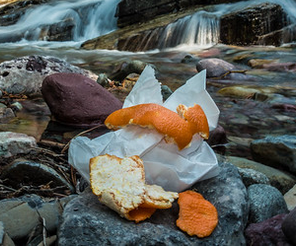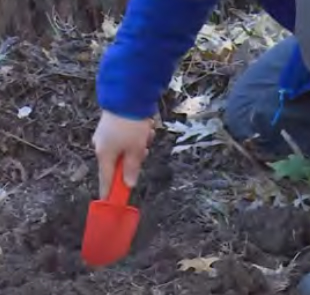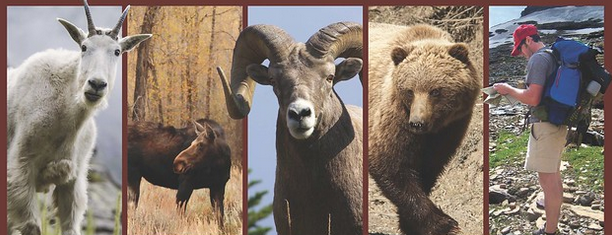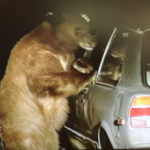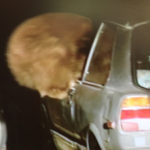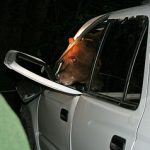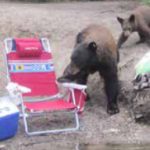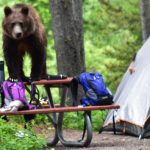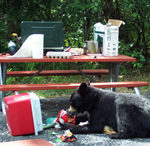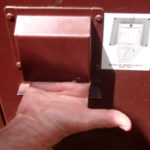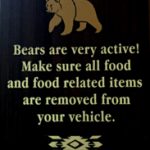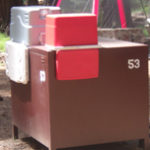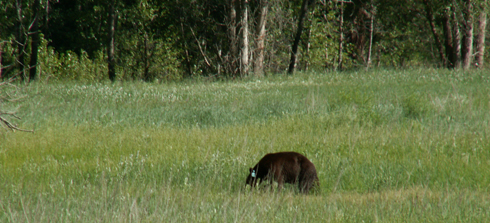Every hiker/camper has experienced trails, campsites, lake shores and meadows near civilization adversely impacted by others. Even far into the wilderness we find hurt to the beauty and health of the outdoor places we love, ranging from litter people didn’t even notice they dropped, to initials carved in trees, driving off-road, trampled wildflowers, animals we won’t be able to watch because they are afraid of people, animals used to being fed tidbits who harass us as we stop to eat at a viewpoint.
A ranger in Grand Teton park wrote about alpine (high altitude)wildflowers: “short growing seasons, wind, intense UV radiation, and heavy snow loads make life in the alpine zone precarious and fragile. Plants may take 300-500 years to recover once trampled or destroyed. Reduce your impacts on alpine vegetation by walking on rocks and staying on trails, when available. Camp on durable surfaces and not on vegetation.”
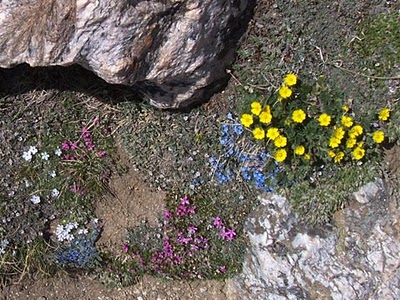

Many people think of Leave No Trace (LNT) skills as for backcounty visitors only, but they certainly apply to car campgrounds, day hikers, public beaches/picnic areas.
Not littering is a simple way to show respect for others, appropriate everywhere.
Checking where we sat to eat for stray twist ties and other microtrash only takes a moment.
Most parks have recycling bins easily available, or we can toss the empties back into the cooler and bring them home with us.
An added benefit to applying Leave No Trace techniques is that we make trips safer and more fun while insuring a positive experience for our group and anyone else we encounter.
Why would people not act to leave no trace of their passing through an area?
Many do not know the effects they have; some don’t take the time to learn regulations.
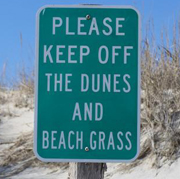
Smokers who leave behind butts are often blissfully ignorant of the fact that they don’t break down easily and of the harm they do to the health of animals who eat them.
Personal resolve is required, but perhaps more important, an in-depth knowledge of LNT (Leave No Trace) principles makes them easier to apply for people who have an environmentally friendly attitude to begin with and want to base their backcountry and frontcountry decisions not only on how actions will impact the environment but also how they may affect other visitors as well.
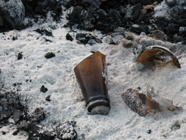 On a walk at a beach with fires allowed we watched as a group packed up their picnic and walked off leaving their fire burning. They might have thought that it would not spread on a huge sandy beach so it was okay to leave it to burn out. But a fire left to smoulder could leave some unseen coals that could cause burns to the paws of the dogs allowed on the beach, or perhaps even to a toddler. We put out the fire and removed a broken beer bottle in the coals. (Please note it is important to put out beach campfires thoroughly with water. If you bury them in wet sand you can also leave unseen hot coals.)
On a walk at a beach with fires allowed we watched as a group packed up their picnic and walked off leaving their fire burning. They might have thought that it would not spread on a huge sandy beach so it was okay to leave it to burn out. But a fire left to smoulder could leave some unseen coals that could cause burns to the paws of the dogs allowed on the beach, or perhaps even to a toddler. We put out the fire and removed a broken beer bottle in the coals. (Please note it is important to put out beach campfires thoroughly with water. If you bury them in wet sand you can also leave unseen hot coals.)
There are many more subtle ways to protect and preserve access to our limited recreational resources.
One person alone can make a difference in the environment by changing their own behavior and being a role model for others.
The impacts of minor actions may seem insignificant, but when multiplied by the thousands of people who hike, climb, boat, camp, etc. every year they are significant and long lasting.
Below are quotes/notes mostly from Yosemite National Park and Grand Teton National Park Leave No Trace and wilderness regulations websites, with a few additions, for the consideration of De Anza College Outdoor Club trip participants.
1. Plan Ahead and Prepare
Grand Canyon rangers say:
Depending on how prepared you are, your trip can be
a vacation or a challenge,
a revelation or an ordeal.
This hiker in Grand Teton National Park has a half liter of diet soda, a park newspaper in his back pocket and not much else. At least he has boots with tread and not flip flops. Is he wearing suncreen?

The Mountaineers Club of Washington climbing code tells us to:
Carry all the necessary clothing, food and equipment at all times.
A little extra preparation can go a long way in reducing your impact on the environment. Plan your trip to avoid sensitive areas, learn in advance any permitting issues, and travel in small groups to reduce impact. Small steps, like re-packaging food and carrying the equipment that you will need to stay warm (a lightweight stove, extra clothing etc.) without having to light a fire, help you to minimize evidence of your passage.
Know the regulations and special concerns of the park. Respect ‘No Trespassing’ signs. If property boundaries are unclear, do not enter the area.
Restrictions on where you can camp are often based on past abuse and the special conditions of an area, hence, people can no longer camp on top of Half Dome in Yosemite.
Prepare for extreme weather, hazards, and emergencies. Be informed of current weather conditions and other area information. Snow or rain camp must-haves
Be physically and mentally ready for your trip. Know the ability of every member of your group. What is the hiking speed /paddling speed of the group’s least capable member?
Select terrain and mileage based on what your group can handle, especially if you don’t get on the road as soon as you thought you would.
Schedule your trip to avoid times of high use.
Visit in small groups. Split larger parties into smaller groups.
Repackage food to minimize waste. If you bring a entire huge box of something you will not actually eat all of, you could end up with leftover spoiling food you think you want to bury rather than pack out. If you repackage the actual amount of food you will eat into ziplock bags and leave the cardboard boxes behind in the recycling bin you will have less to pack out. One-pot meals contribute to the creation of less bulk and therefore less garbage.
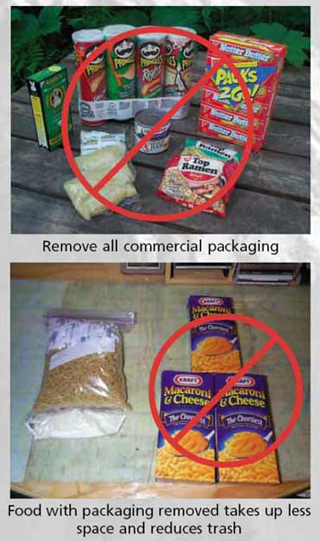 using a bear resistant food storage container has how-to info and advice on how to fit more in each container.
using a bear resistant food storage container has how-to info and advice on how to fit more in each container.
A California Regional Park near a city warned:
Be prepared for crowded parking lots, trails and potential closures. Parking lots at some of our more popular parks and trailheads can fill early on weekends and holidays. Plan to arrive early in the morning or later in the day for the best chance of finding parking.
Avoid parking in residential neighborhoods. If a parking lot is full, have a “Plan B” destination in mind.
Grand Teton National park offered these at their Wilderness Ethics page:
Leave No Trace – Climbing
PLAN AHEAD AND PREPARE
- Minimize leaving fixed protection and anchors in the mountains. Review route descriptions to find out locations of existing rappels, belay stations and fixed pitons and minimize the creation of new/unnecessary anchors.
- Motorized drilling is not allowed. Power drills and other motorized equipment are not permitted in the backcountry. Please consult with Jenny Lake District Ranger Chris Bellino prior to installing any new hardware. He can be reached through the Teton Interagency Dispatch Center at (307) 739-3301.
- Do not build cairns. Cairns may assist hikers and climbers with route-finding, but too many cairns create confusion and resource damage when hikers are incorrectly directed off-route.
2. Travel and Camp on Durable Surfaces
To leave a lighter footprint, travel and camp on durable surfaces, including pavement, rock, gravel, dry grass and snow.
A California Regional Park near a city warned:
“Walk, ride and photograph on designated trails. Designated trails are intentionally built and help to prevent erosion and protect vegetation from being trampled. Once damaged, vegetation may not grow back. Trail maps are posted at park entrances or can be downloaded from a park’s webpage.
Stay back from the bluffs.
Be careful when taking photos near coastal cliffs. While the backdrop can be enticing, the rocks and shale formations are unstable. Stay on designated trails and heed warning signs.”
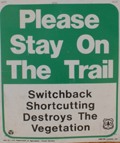 In popular areas, stick to established trails to concentrate impact and preserve the surrounding areas. Walk single-file in the middle of the trail, even when wet or muddy. (Even when it is slower and harder to walk in the worn trail, don’t start a new line of wear next to the existing trail.)
In popular areas, stick to established trails to concentrate impact and preserve the surrounding areas. Walk single-file in the middle of the trail, even when wet or muddy. (Even when it is slower and harder to walk in the worn trail, don’t start a new line of wear next to the existing trail.)
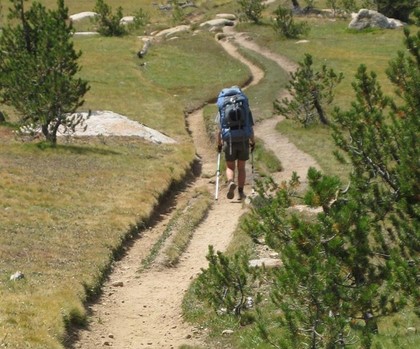
This next NPS photo had this “If you take an alternate route around puddles, a new trail can quickly form, damaging sensitive vegetation. . .”
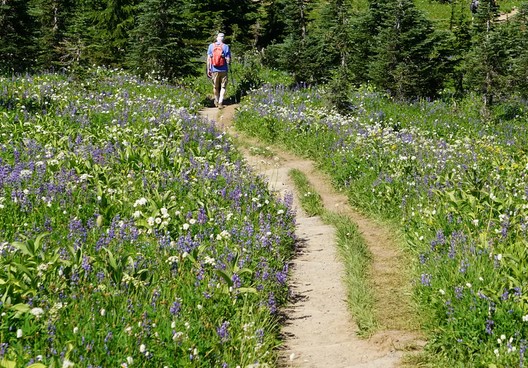

In places where few people ever go, spread out to disperse your impact, and avoid areas where impact is visible.
Stay on the existing trail, never shortcut switchbacks.
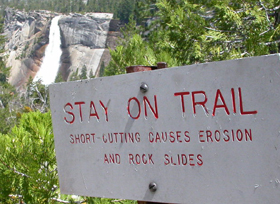
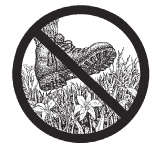 When you stop to rest, be careful not to mash vegetation. Sit on rocks, logs, big granite slabs or in clearings.
When you stop to rest, be careful not to mash vegetation. Sit on rocks, logs, big granite slabs or in clearings.
Good campsites are found, not made. Altering a site is not necessary. Don’t build rock furniture.
Good places to pitch a tent are found, not made, please don’t cause erosion by digging trenches around tents.
In popular areas:
Concentrate use on existing trails and campsites. (In some places you must camp at designated, already worn out sites.) Except at a designated backcountry campsite, don’t camp near water. Camp at least 200 feet away from water sources and use already worn trails to get to the water source. It is probably against the rules of your permit to camp near water because areas near water are more fragile and animals who need to get to water my be frightened away.
Use a large plastic water container to collect water so you don’t need to make frequent trips to the water source.
Keep campsites small. Restrict activities to the area where vegetation is compacted or absent.
 This can be applied even in a campground accessible to cars. In this photo on the right we see a worn out campsite typical of major campgrounds. It is at the end of a loup and has a small meadow to the left in the photo. Unfortunately the current occupants pitched their fourth tent in the meadow and wore out plants coming and going that weekend.
This can be applied even in a campground accessible to cars. In this photo on the right we see a worn out campsite typical of major campgrounds. It is at the end of a loup and has a small meadow to the left in the photo. Unfortunately the current occupants pitched their fourth tent in the meadow and wore out plants coming and going that weekend.
In pristine areas:
Disperse use to prevent the creation of new campsites and informal trails.
Avoid places where impacts are just beginning. (Just stepping once with your big boots on some tiny 100 year old high altitude plants can kill them.) Do not clear new tent sites or build windbreaks. It is permissible to use existing established rock windbreaks. Moving rocks exposes fragile roots of alpine plants and causes the plants to die. Alpine plants depend on the shelter of rocks to survive.
If there is no designated campsite, choose a previously impacted campsite at least 100 feet (30 meters/40 paces) or as required by your permit, from any water source or trail. Choose a site that is not visible to others.
Avoid enlarging existing sites and never scrape or clean a site of leaves and needles. This cushion is necessary for erosion and trampling control.
You may see trails rerouted or campsites closed so scars from overuse can heal and plants can reestablish. Please respect these efforts by staying out of closed areas and by using existing trails.
The Boy Scouts warn: “Cryptobiotic crust, found in desert environments, is extremely vulnerable to foot traffic. Cryptobiotic crust consists of tiny communities of organisms that appear as a blackish and irregular raised crust up on the sand. This crust retains moisture in desert climates and provides a protective layer that helps prevent erosion. One footstep can destroy cryptobiotic crust for decades. It is important to use developed trails in these areas.”
Grand Teton National park offered these at their Wilderness Ethics page:
Leave No Trace – Climbing
TRAVEL AND CAMP ON DURABLE SURFACES
Use established approach trails and routes. Do not create new approaches or descent routes. Do not shortcut across switchbacks, as this practice causes erosion and can destroy an otherwise good trail.
Protect the Alpine Environment. Short growing seasons, wind, intense UV radiation, and heavy snow loads make life in the alpine zone precarious and fragile. Plants may take 300-500 years to recover once trampled or destroyed. Reduce your impacts on alpine vegetation by walking on rocks and staying on trails, when available. Camp on durable surfaces like rock or snow and not on vegetation.
Disperse your footsteps when walking off-trail. Do not walk in a single line through pristine alpine vegetation. Disperse your impacts to avoid creating a new trail. When possible, walk on rocks, gravel, snow or other durable surfaces.
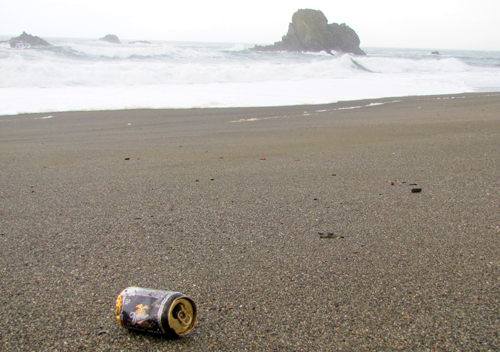
3. Dispose of Waste Properly. Pack It In, Pack It Out.
It is essential to maintaining the beauty of our parks to take all the things you brought in back out with you again, including all trash, leftover food, and litter. In many parks it is against the law to burn trash, pack it out. Don’t bury any trash, or dump anything in the backcountry outhouses, even orange peels. Don’t try to burn tin foil, it just turns into ugly specks in the firepit. Don’t try to burn tea bags, excess food, coffee grounds, etc. Burning organic matter completely requires a very hot fire, hotter than most campfires.
When you return to civilization, look for proper recycling bins, and the NPS advises: prevent contamination by rinsing and sorting items before you recycle- food/liquid residue or missorted items can cause an entire recycling load to be thrown out.”
A California Regional Park near a city warned:
“Take your raft or tube home with you. You brought it along — don’t leave it behind. When left onshore or in the water, rafts, tubes and other floats harm wildlife and the river ecosystem.
Pack out all fishing lines and hooks. Discarded fishing lines and hooks cause unnecessary harm to birds and other aquatic wildlife. An accidentally swallowed fishing hook can lead to suffering and death.”
Protect wildlife from your food by storing food and trash securely. How to use a bear-proof food storage locker.
When we get to our campsite we always inspect it for trash or spilled foods and clean it up (including one year, recent horse droppings in an area where horses were not allowed, (no we didn’t pack them out, we just moved them to an appropriate place at the edge of the trail).
Be careful with small pieces of trash such as candy wrappers and twist ties that often fall out of pockets and litter trails. If you used a candle lantern, watch out for and clean up wax drippings. Don’t bury any trash, even orange peels you think will biodegrade.
Please pick up after less thoughtful people who have gone before you.
Have a small trash bag handy on the trail, big enough for more than your own trash. We have had competitions to see who could find and clean up the most (or weirdest) litter. Check your campsite and lunch stop for microtrash —look for bandages, twist ties, fruit peels, bits of wrappers, etc.
If a bear does get your food, you are responsible for cleaning up and packing out all debris, and for reporting it to the nearest ranger.
Climbers can consider this about fixed ropes: “Most of Yosemite’s climbing areas are in designated Wilderness and must remain “without permanent improvements or human habitation… with the imprint of man’s work substantially unnoticeable.”
Wilderness, and climbing in particular, is not intended to be convenient or easy (ironically that’s why many are drawn to it). Please do your part to maintain Yosemite’s wildness. In 2001 volunteers and rangers removed over four thousand feet of trash rope from Yosemite’s walls, not including a few thousand feet of junk rope from the Heart Ledge rappels by conscientious climbers.”
and see Food Storage while Climbing. https://www.nps.gov/yose/planyourvisit/bears-climbing.htm
______________________________________________
____________________________________________________________
There are no restrooms, privies or outhouses along most trails in the wilderness, or even close in to many developed areas in parks.
After we get to a trailhead (start of a hiking trail), after we have unloaded and packed up gear in our kayaks & canoes, we always plan to make one last stop at a restroom / outhouse, even if people are sure they don’t reeeealy need to, to prevent having to dig one more hole in the wilderness.
To deposit solid human waste, start by setting duff, pinecones, twigs aside carefully, then dig the hole. Mount Rainier says: “to promote decomposition, choose a site in organic soil rather than sandy mineral soil.” Cover and disguise the cathole when finished by replacing duff, pinecones, etc.
(Yosemite) Deposit solid human waste in catholes (personal latrine) dug six inches deep at least 100 feet from water, camp, and trails.
(Grand Teton) Prevent contamination of waterways by burying feces in a hole 6-8 inches deep at least 200 feet from streams, lakes and wetlands.
(Everywhere) Pack out used toilet paper, tampons, sanitary napkins and diapers in sealed plastic bags. Do not bury or burn them or dump anything in the backcountry outhouses. If you are in snow and can’t dig a hole into soil you are expected to pack out your waste as well.
It isn’t possible to dig your cathole deep enough by scraping the soil with your boot heel/rock/stick, carry a small lightweight garden trowel (lower cost than some for sale at recreation supply stores). You can pack it in a small bag with the toilet paper, trash bag for the used toilet paper, and some hand sanitizer or wipes (that need to also go into the trash bag after use).
To truly be able to leave no trace and follow backcountry rules about camping the proper distance from a lake or digging your personal latrine hole the proper distance from water, etc., you will need to know how far 100 or 200 feet is. Lay out a tape measure at home for 100 feet and walk it and count your paces.
Digging one big latrine for multiple people to use is not recommended, as “the digging and use of temporary latrines by backcountry visitors is almost always an inappropriate method for disposal. The larger the concentration of feces, the more time needed for decomposition, which increases both the likelihood that feces will be discovered by other visitors and that pathogens will come into contact with ground water.”
Urinate on durable surfaces (rocks, gravel, or snow) that will not be damaged by animals digging for salts and minerals found in urine. Dilute the urine with a sprinkling of water.
Yosemite video on How to Poop in the Woods, which you will find links to at many National Park webpages:
https://www.nps.gov/media/video/view.htm?id=AEC52765-A123-6C46-F9251B8977933EDE
At many parks, in alpine zones and/or for all climbers, you must pack out all your own waste. See human waste and trash at: ‘The rules (and their reasons) while climbing in Yosemite’, http://www.climbingyosemite.com/services/regulations/
(Grand Teton) “On Jackson lake all solid human waste must be removed from any campsite or shoreline area for proper disposal. At the Lower Saddle in Garnet Canyon, all solid human waste must be carried out. In Garnet Canyon and in other high-use areas, such as Hidden Falls and Inspiration Point, it is also suggested that solid human waste is carried out. Bags for removal are given out at several locations.”
Proper waste disposal not only keeps the backcountry looking pristine, it is extremely important for health and safety of campers and wildlife.
Over 100 bacteria, protozoans, and viruses are potentially present in human feces and capable of causing illness.
____________________________________________________________
______________________________________________
More advice from Yosemite for rock climbers: “Don’t leave food or water at the top or on ledges for future parties…Don’t leave fixed ropes as permanent fixtures on approaches and descents. These are considered abandoned property and will be removed…Clean extra, rotting slings off anchors when you descend. Bring earth-toned slings to leave on anchors.” “Gardening (the name given to removing plant life from cracks) is not allowed in Yosemite. Many climbers remove the occasional bit of grass or leaves to place protection or find a finger-lock, but this is nothing compared to the serious damage done by establishing a new area” (or new route/bolt to replace the thousands of established climbing routes).
and for BOULDERING
Take the time to find and follow established approach trails when hiking to bouldering areas.
Never cut or break tree limbs, remove excessive lichen, or damage vegetation to establish a boulder problem. Maybe some problems weren’t meant to be climbed… and there are many more still left that don’t necessitate gardening.
Keep bouldering areas clean. Pick up your trash, even the little stuff (cigarette butts, tape, wrappers, etc.)
Think twice before putting down the pads. Bouldering pads protect our ankles but trash fragile plant life. If the area looks fragile, maybe find an extra spotter and skip the pad.
Do you really need to chalk up again? Try to minimize chalk use and clean off chalked holds when possible, especially on overhung routes where rain doesn’t hit. If you tick holds, clean the marks when you’re done.
______________________________________________

Take an extra moment to think before you pack your food/create a menu.
Cooking more than you eat gives you inconvenient, often heavy, leftovers to pack out.
On our Teton kayak overnight it would be more responsible to 1) have no-cook meals or 2) hot meals that only require pouring boiling water over food or 3) wait to clean other pans until we get back to civilization.
(Backpacking Advice has no-cook meals advice.)
If you must wash yourself or your dishes, carry water 100 feet away from streams or lakes and use small amounts of biodegradable soap. Strain food particles from dishwater and pack them out so they don’t attract animals. Scatter dishwater at least 100 yards from the campsite. Do not put any soap in water (even biodegradable and ‘natural’ soap pollutes). You really don’t need to wash your hair on a one night overnight. Think hat/bandanna/braids. On a one night overnight when we kayak in we can afford the weight of unscented baby wipes for personal freshness instead of leaving behind soapy washwater at all. Camping solutions for women
Cigarette butts are not biodegradable. Smokers choose filtered cigarettes to be able to breath in less tar, formaldehyde and hydrogen cyanide. When the filters are left to decay they can release toxic chemicals including the pesticide nicotine, benzene, lead, arsenic and cadmium into soil and waterways. Recent experiments show that one butt has enough poisons to kill half the minnows in a liter of water, (a standard laboratory test for toxins) in 96 hours. It only takes two butts to make a small animal seriously ill or even kill them.
“[Cigarette butts] also present a threat to wildlife. Cigarette filters have been found in the stomachs of fish, birds, whales and other marine creatures who mistake them for food … Composed of cellulose acetate, a form of plastic, cigarette butts can persist in the environment as long as other forms of plastic.”
–Clean Virginia Waterways
“Cigarette waste is the most commonly littered item in the US,
with 1.69 billion pounds polluting the environment every year.”
“While many people believe that cigarettes are biodegradable, the filters in almost all cigarettes are actually made of cellulose acetate, a type of plastic. When disposed of improperly, they release a long list of harmful chemicals into the environment (cadmium, lead, formaldehyde, arsenic, etc.). In addition to these challenges, carelessly tossed cigarette butts can also start forest fires, potentially damaging hundreds or thousands of acres, or make their way into the nests of birds and other animals along with other micro-trash items.”
Grand Teton National park offered these at their Wilderness Ethics page:
Leave No Trace – Climbing
DISPOSE OF WASTE PROPERLY
Clean up tattered anchors. Help keep the alpine environment pristine and clean up tattered anchors by cutting out worn pieces of webbing and cord from established anchors and packing it out. Remove unnecessary anchor stations. Pack out any other trash or garbage you find on routes.
Use Rest Stop Bags. Pack out solid human waste and toilet paper on alpine climbs. There is no good place to dig a cat-hole on alpine climbing routes and solid human waste left under rocks can last a long time in that environment.
4. Leave What You Find
Preserve the past: examine, but do not touch, cultural or historic structures and artifacts. Some places say climbers should not disturb old pitons.
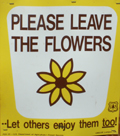 Leave rocks, plants, seeds, feathers and other natural objects as you find them. Shenandoah National Park suggests: “Take pictures, write poetry, or sketch to help you remember what you discover here.”
Leave rocks, plants, seeds, feathers and other natural objects as you find them. Shenandoah National Park suggests: “Take pictures, write poetry, or sketch to help you remember what you discover here.”
You might not see all of them but on popular trails there can be over a thousand people hiking per day. If everybody on a given trail on a given day took “only one” flower out of that meadow there really would be none left for others to enjoy. Finding an antler, arrowhead, nest, fossils, pot sherds, stone points, dinosaur bones, or petrified rock can be a special experience, leave them for others to be as lucky. The principle of leaving what you find undisturbed even applies to the rocks, pretty colored pebbles and pinecones that there seem to be so many of.
Many parks allow people to consume edible berries, picked by hand, for personal daily consumption, but not for canning, freezing. Are you quite certain you know which berries are safe to eat?
A California Regional Park near a city advised “Leave it as You Find It”:
“Leave sea stars, shells, rocks, and wildflowers as you find them so others can also experience the thrill of discovery. A photograph makes for a much better keepsake – and preserves these natural treasures for everyone to enjoy.
Treat wildflowers and other living plants with respect. Picking, carving, hacking or peeling plants and trees can harm or kill them.
Leave gates as you find them. Many of Sonoma County’s open spaces are used for grazing animals like sheep, cattle and goats. Keep gates open when already open, and closed when already closed. Intentionally tampering with grazing fences can result in harm to people and animals.”
Do not build structures, furniture, tree bough beds. Never hammer nails into trees or girdle trunks with tent lines. Avoid leveling the tent site.
Climbers should not chisel or glue holds.
Don’t dig trenches around your tent…even if it is really, really, really rainy.
Use the hammock at home, it will damage, even if it is ever so slightly, the tree you tie it to.
Avoid introducing or transporting non-native species. Before entering a park, check all vehicles, clothing, (including your boot treads) and gear for weed parts and seeds, and remove them. Some potential firewood should not be transported to new areas, as in “sudden oak death.” https://www.nps.gov/yose/learn/nature/forest-pests.htm
Help stop aquatic hitchhikers.
Remove any visible mud, plants, fish or animals before transporting aquatic equipment.
Eliminate water from equipment before transporting.
Clean and dry anything that came in contact with water (Boats, trailers, equipment, clothing, dogs, etc.).
Never release plants, fish or animals into a body of water unless they came out of that body of water.
https://www.nps.gov/grte/planyourvisit/ans.htm
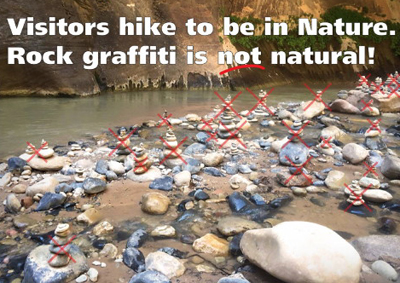
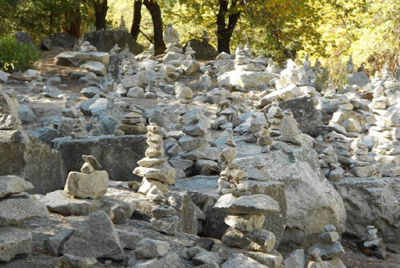
Rock graffiti (building cairns, stacking stones) is not natural. It is not worse than carving your initials in a tree, or scratching your name on sandstone, but it is still graffiti and vandalism.
Zion National park notes: “Rock stacking in national parks may seem harmless, or even fun to make, but we invite you to reconsider the problem they pose from a broader perspective. On the one hand, hiking in nature should provide an escape and a refuge from the everyday mundane life. That refuge, ideally, should be in an unadulterated natural setting (or minimally so). Rock graffiti, even if seemingly impermanent, disturbs the natural state of the environment for other visitors, and have a permanent ecological impact. Also, be aware that it is considered by the National Park Service as a form of vandalism and it is illegal…”
Grand Teton National park offered these at their Wilderness Ethics page:
Leave No Trace – Climbing
LEAVE WHAT YOU FIND
No Construction Zone. Do not create new bivy sites by clearing ground and moving rocks. Camp on durable surfaces and use camp sites that have already been established.
Leave cultural resources unimpaired. Do not disturb historic or archaeological areas and structures. This includes old pitons and early climber caches and ‘trash’.
Preserve rocks and routes. Scarring, chiseling or gluing holds is illegal and not permitted in the park.
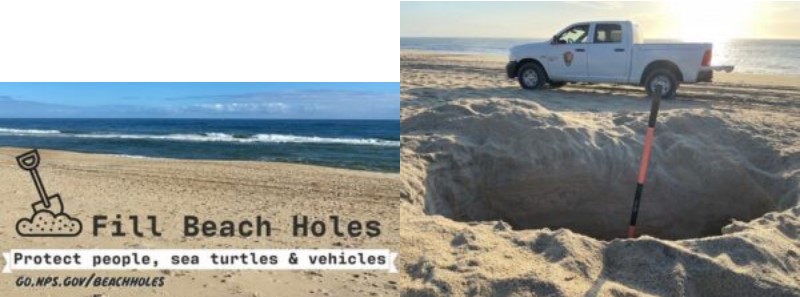
Cape Hatteras National Park has beaches that people can drive on to. At their webpage they say:
“The beaches of the Outer Banks are home to an ecosystem of plants and animals, and provide amazing opportunities for rest, relaxation, and inspiration. These beautiful beaches attract millions of visitors a year, and we all have an obligation to ensure they are left in their natural, enjoyable state.
It is hard to imagine going to a beach and not playing in the sand. However, recent trends in digging deep holes and abandoning them have started to negatively impact nature and visitor safety.
Beach Hole Safety Tips
Avoid digging deep holes in the beach.
If you dig a hole in the beach, fill it in before leaving the beach. Dig a hole, fill a hole.
Do not dig holes deeper than your knees when standing in them.
If you see an abandoned beach hole, consider filling it in.
Digging deep holes and abandoning them can cause serious harm to beachgoers, emergency response staff, and sea turtles. Cape Hatteras National Seashore wants you to build your sandcastle, play in the sand, and enjoy every aspect of the beach. We just ask that you resist the urge to dig deep, dangerous holes. And, if you see an abandoned hole in the beach, consider helping out your fellow beachgoer by filling it in, if possible. Let’s #FillBeachHoles.
5. Minimize Campfire Impacts
Campfires can cause lasting impacts to the backcountry. Instead, consider using a lightweight stove for cooking and a candle lantern for light. Even if you think you can have a legal campfire, you should have a stove to cook on as fires may be suddenly prohibited due to dry weather or impossible due to heavy rain.
Fires are permitted with a wilderness permit in Yosemite wilderness areas, unless otherwise noted. No additional fire permit is needed. However, fires are allowed in existing fire rings only, and prohibited above 9,600 feet in elevation (Yosemite) above 10,400 feet (some other parks).
Fires are prohibited in Teton backcountry camping zones in the mountains. On Jackson Lake, Leigh Lake and Phelps Lake they are allowed most of the time in existing grates only.
Use dead and down wood only. Only use sticks from the ground that can be broken by hand, do not break dead branches off trees. Do not burn any trash, including toilet paper. Don’t try to burn tin foil, it just turns into ugly specks in the firepit and releases chemicals.
Use established fire rings or fire pans, don’t build new fire rings and create more blackened rocks.
Keep fires small. Don’t try to burn a huge log. Use only dead and down wood which is wrist size or smaller so that it can be burned completely before you leavthe campsite. Burn all wood and coals to ash and put out campfires completely.
Extinguish all campfires when unattended.
At any designated backcountry campsite, all the burnable, not green, not rotted firewood has been used up by others. On our kayaking wilderness overnight in Grand Teton we stop during the portage, collect firewood a bit off trail, fill available space in the kayaks and always have plenty for ourselves and to leave some behind for others. We clean out the bits of trash from the firepit, and litter in the campsite when we arrive and check again before leaving.
With the potential exception of roasted marshmallows, we only cook on a stove in the wilderness. Save the BBQ and it’s animal attracting drippings, for established not-backcountry campgrounds. Save the pasta meals that require a huge pan of water to boil (and require strained water disposal after) for the established not-backcountry campgrounds. Backpacking Advice includes low-cook foods ideas.
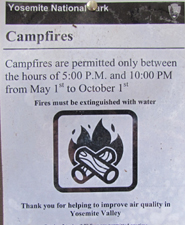 Reasons campfires might be banned by a park you visit include: a ban on fires due to dry weather, certain times of the day in places where they create smog (like Yosemite Valley), ban on fires where there is not a lot of down firewood and where collecting the few dead branches would leave less for the insects and animals that depend on them (for example, at high elevations).
Reasons campfires might be banned by a park you visit include: a ban on fires due to dry weather, certain times of the day in places where they create smog (like Yosemite Valley), ban on fires where there is not a lot of down firewood and where collecting the few dead branches would leave less for the insects and animals that depend on them (for example, at high elevations).
A cliff face blackened from campfire smoke not only is ugly, it shows that the people did not know how to stay warm. They built their fire up against the cliff face or huge boulder to try to reflect the heat towards them. If they had set the fire away from the rock and used the rock face as a backrest they would have been warmer.
On ocean beaches where fires are allowed, please find out where on the beach they are okay. Some places require that fires be built below the high tide line where the fire scar will have washed away within 24 hours. Some require you not collect and burn beautiful driftwood, or say you can if it is smaller than an adult’s arm.
A campfire after midnight, (or even after 10) makes that lake you are camping on seem less of a wilderness area to others who might wake up and want to sit on the shore and stargaze. Help preserve their wilderness experience.
Campfires
6. Respect Wildlife
Safe Distances from Wildlife includes reasons to stay away from even friendly seeming animals in parks, and charts and photos to better be able to determine and visualize how far away from wildlife you need to stay to be safe (and obey laws that do have penalties).
Sharing wilderness with the animals that live there is a particularly rewarding experience and also a delicate balancing act. Pursuing an animal to get that perfect picture, or luring them closer with your lunch, destroys that balance and endangers the wildlife. Protect wildlife by maintaining a healthy distance and keeping your food secure.
Loud noises and quick movements are stressful to wildlife. Many birds are sensitive to human presence and may abandon their nest if disturbed, even during the nest building stage. If they abandon the nest even briefly when there are eggs or chicks they may not survive, hence the seasonal trail closures or complete closures of some islands for nesting swans and Bald Eagles. Some climbing routes in Yosemite are closed each year from March 1 until August 1 or until the young falcons of the current year have fledged. You will really want your own binoculars on our Tetons trip.
Willfully remaining near or approaching wildlife, including birds, within ANY distance that disturbs or displaces the animal is against the law. Feeding, touching, teasing, frightening, or intentionally disturbing wildlife is prohibited. https://www.nps.gov/grte/planyourvisit/wildview.htm
When bears get used to human food Rangers have tried trapping and relocating them, but they almost always come back. Hazing them sometimes works, but most often they have to be killed when they get too close to people. An average of about 1 black bear a year is killed by park officials in Grand Teton National Park “because of human food conditioning and aggressing behavior that threatens humans. Many of the incidents that result in bears becoming human food conditioned occur in campgrounds due to visitors’ non-compliance with food storage regulations.”
Observe wildlife from a distance. Do not follow or approach them.
Many park have regulations that observing wildlife after dark by artificial light is prohibited.
Never feed animals. Feeding wildlife damages their health, (think UN-nutricious food, tooth decay, gum infection, and ulcers), alters natural behaviors, and exposes them to predators and other dangers.
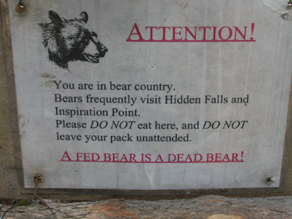
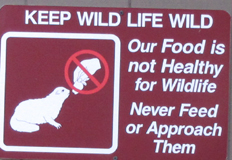
Many parks have regulations that require that day packs, and backpacks with food/snacks in them not be left unattended. Ravens have learned how to unzip packs. Ground squirrels can quickly chew into packs and bears can certainly carry them away.
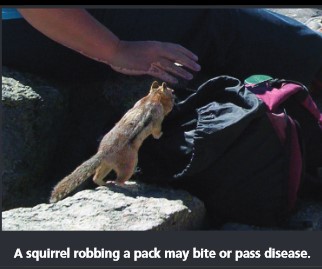
Leave pets at home. (Or at least follow minimum length leash laws in park areas where dogs, etc. are allowed.)
Avoid wildlife during sensitive times: mating, nesting, raising young, or winter.
Animal calls, audio attractants or other means of attracting or disturbing wildlife are prohibited.
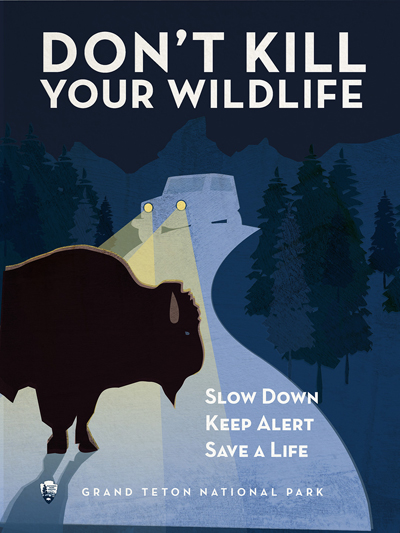
Drive the speed limit. “Watch for wildlife crossing the roads at dusk and dawn and drive with caution at night; bison are especially difficult to see at night and can weigh up to one ton.”
Results of a collision with a bison:
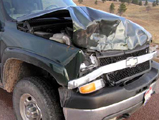
and see Before a Bison Charges

“Don’t pick up or touch baby birds and other young wildlife. Many baby birds can be found on the ground when they first leave the nest and are NOT orphaned, sick, or injured. It is normal for young birds that are not yet able to fly to be on the ground. In fact, most species of hawks and owls continue to feed and care for their young well into the fall months. Please help these baby birds survive by keeping pets on-leash and leaving the area immediately so the parents can care for their young safely while they are on the ground. (Yosemite, 7/10/09) ”
(Grand Teton) Be a Responsible Wildlife Observer
Use binoculars, spotting scopes or long lenses for close views and photographs. Always maintain a safe distance of at least 100 yards from large animals such as bears and wolves, 25 yards from other wildlife and nesting birds.
Never position yourself between an adult and its offspring. Females with young are especially defensive.
It is illegal to feed wildlife, including ground squirrels and birds. Feeding wild animals makes them dependent on people, and animals often bite the hand that feeds them.
Do not harass wildlife. Harassment is any human action that causes unusual behavior, or a change of behavior, in an animal. Repeated encounters with people can have negative, long-term impacts on wildlife, including increased levels of stress and the avoidance of essential feeding areas.
Nesting birds are easily disturbed. For wildlife, raising young is a private affair. If an adult bird on a nest flies off at your approach, or circles you or screams in alarm, you are too close to the nest. Unattended nestlings readily succumb to predation and exposure to heat, cold, and wet weather.
Allow other visitors a chance to enjoy wildlife.
The park service says “If your actions cause an animal to flee, you have deprived other visitors of a viewing opportunity. Use an animal’s behavior as a guide to your actions and limit the time you spend.”
The Forest Service also also reminds us:
“YOU ARE TOO CLOSE TO WILDLIFE IF:
· The animal stops feeding or resting.
· The animal starts moving either toward or away from you.
· The animal starts panting, huffing or making unusual sounds.
· The animal begins pawing the ground or swinging its head.
· Neck hair or feathers stand up.
· The animal appears nervous, uneasy or stressed.
If you notice these signs you are disturbing the animal and it is time to slowly move away.The safest way to view wildlife is through binoculars or spotting scopes.”
Respect Public Use Closures. Check at visitor centers, wilderness permit centers and boat ramp bulletin boards for areas that have been closed to protect park visitors, park wildlife, and other sensitive resources. Closed areas are not always posted with signs.
In Grand Teton there are seasonal closures of areas near nests. They include Feb. 1 – Aug. 15 within a half mile of Bald Eagle nests and April 1 – Sept.1 within 330 feet of Osprey, Trumpeter Swan, Peregrine Falcon and Great Blue Heron nests, or as posted. Also within a mile of wolf dens, or as posted. (Please check with any park when you arrive as this webpage can’t be kept up to date on a daily basis and rules can change.)
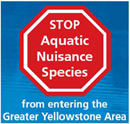 On our Grand Teton trip, boats, and anything that comes in contact with the water (a boat trailer that you drive into the water to launch, waders, paddles, Tevas, nets, etc.) must be cleaned before use in the park. They must be cleaned again before use in Yellowstone waters and again when you come back to the Tetons.
On our Grand Teton trip, boats, and anything that comes in contact with the water (a boat trailer that you drive into the water to launch, waders, paddles, Tevas, nets, etc.) must be cleaned before use in the park. They must be cleaned again before use in Yellowstone waters and again when you come back to the Tetons.
http://www.nps.gov/grte/planyourvisit/ans.htm
 New Zealand mud snails, shown on a dime in this NPS photo, are only about a quarter of an inch long. They form dense colonies on rocks and aquatic vegetation and crowd out native aquatic insect communities, which are a primary food for fish, which are food for many animals. They also eat the majority of alqae growth in streams, which is a primary food for aquatic invertebrates.
New Zealand mud snails, shown on a dime in this NPS photo, are only about a quarter of an inch long. They form dense colonies on rocks and aquatic vegetation and crowd out native aquatic insect communities, which are a primary food for fish, which are food for many animals. They also eat the majority of alqae growth in streams, which is a primary food for aquatic invertebrates.
Grand Teton National park offered these at their Wilderness Ethics page:
Leave No Trace – Climbing
RESPECT WILDLIFE
Route Sharing. Climbing routes and peaks are closed at times to protect sensitive wildlife. Ask about nesting closures for raptors and other wildlife closures at the Jenny Lake Ranger Station.
7. Be Considerate of Other Visitors
Respect other visitors and protect the quality of their experience. Loud and rowdy behavior is not only gets in the face of other campers, it can also be dangerous, and having to get a trip member with a broken leg or even just a sprained ankle out of the backcountry becomes time and energy consuming for everyone. When people play active games they often forget they are starting to trample a small meadow and can even forget the location of that stove with water boiling on it, trip on it and get a bad burn. Save the flag football and hacky sack games for closer to hospitals.
Be courteous. Yield to other users on the trail.
Horses and pack stock (mules, llamas) have the right-of-way. On most trails, step to the downhill side of the trail when encountering horses or pack stock and remain quiet. (In Grand Canyon it is required you step off the trail on the uphill side away from the edge.)
Follow the direction of the wrangler. Remain completely quiet and stand perfectly still.
Do not return to the trail until the last mule is at least 50 feet (15 meters) past your position.
Bicyclists must yield to horse and foot traffic and on most backcountry trails, mountain biking is prohibited. Where cycling is okay, control your speed and let others know before you pass. You might say something like ‘passing on your left’ as you approach them.
Where bikes are allowed foot traffic should not walk side by side on narrow trails when bike traffic is approaching and make the cyclist stop. Move over into single file and share the trail.
Forest Service River Etiquette:
“By following a good river etiquette, you can help others have an enjoyable experience.
To reduce congestion at river launches, always prepare and de-rig your boat away from the boat ramp.
Smaller boats should give the right-of-way to larger, less maneuverable boats.
Allow the boat ahead of you to pass through a rapid before you begin your approach.
Please keep the river clean by using designated restrooms and packing out garbage.
Be considerate. Not everyone welcomes a water fight.”
Take breaks and camp away from trails and other visitors on an already worn out or rocky space. Exceptions include officially designated wilderness campsites you must use, or some trails where you MUST remain on the trail such as the meadows in Mount Rainier at Paradise, Sunrise and Tipsoo Lake, even for a lunch stop or to take a picture.
Please don’t hike or snowshoe in Nordic (cross-country) ski tracks. Walk alongside, but not in the ski trail.
Imitating the bugle of the elk or the howl of a coyote you just heard is actually illegal in many parks and quite in the face of neighbors.
Early morning hikers should notice whether the people in the backcountry campsite(s) they are passing are still in their tents or are up and around. If they are not up, your talking/laughing as you hike can wake them up.
Choose hiking, backpacking, and camping gear and clothing that are natural earth tone colors like green, brown, tan. (Some Leave No Trace websites also recommend black but it, along with flowery prints and bright colored clothing, attract insects that sting.) Bright colors like white, purple, blue, red and yellow do not blend in with the environment, can be seen from miles away and contribute to a crowded feeling. But do carry at least one item of very visible clothing and/or gear to help rescuers find you if needed.
Where there are backcountry food storage lockers — share — that locker is not meant for your whole backpack. Pack out your trash, don’t leave it in the locker.
Trail Courtesy Practices That Leave No Trace
is a great page from Grand Canyon National park which includes how to pass slow hikers on a trail, give uphill hikers and mules on trails the right of way and more hiking etiquette.
Let nature’s sounds prevail.
Allow for others to enjoy the peace and solitude of being in the backcountry. Let others in front-country campgrounds stand a chance of hearing the birdsong, nearby water sounds, winter avalanches off the cliffs, coyotes singing.
Turn off cell phones unless you must use them, if you do use a cell phone, use it out of sight and sound of other people.
No amplified music in the wilderness. And in many established frontcountry campgrounds, the rules say if you bring a boombox to play use it sit near it and turn it down low, so it can’t be heard very far away from you so you don’t spoil other people’s wilderness experience.
Grand Teton National park has an announcement that some park visitors seem to not have learned about:
“Be thoughtful of how music may affect others. Operating an audio device, such as a stereo, Bluetooth speaker, radio, or musical instrument in a manner which is unreasonable and impacts park users is prohibited by law.”
Turn off the car stereo before you enter the campground, and don’t use your car stereo to broadcast music to the campsite. The best music solution really is to bring headphone cassette players so you can play whatever music you want as loud as you want.
If you arm your car alarm it will go off when a coyote puts his paws up on a window to get a look inside, waking up the whole campground. On the Outdoor Club winter Yosemite trip, if you think you really need to use your car alarm, someone can drive you back when you park your car at day-use.
! ! ! ! Tent walls are thin. You can wake up everybody in the vicinity ! ! ! ! when you want to get into your car and you use the keyless (remote) door opener and the car makes the usual loud beep. People don’t think to just use the key to open the door or don’t know that if you look in the owner’s manual you can find a way to disable the beep. On De Anza Outdoor Club trips you are required to either disable the beep or not use the remote (remove it from your key chain during the trip) or park at day use instead of at the campground.
Some vehicles have a beep activated whenever you open the trunk, that can’t be easily disabled. Every time the trunk is opened it beeps and it will wake up people on our trip and in neighboring campsites. If your vehicle has this function, either look in the owner’s manual for info on how to disable the beep or take it to the dealer and get it done, or do not park it at our campground.
Grand Teton National park offered these at their Wilderness Ethics page:
Leave No Trace – Climbing
BE CONSIDERATE OF OTHER VISITORS
- Be Courteous. Let faster parties pass on climbing routes when safe to do so.
- Get away from it all! Choose routes that are less popular to help alleviate overcrowding. Get an early start on climbs that are popular.
—————————————————–
The original Leave No Trace: Center for Outdoor Ethics webpage is at: http://www.lnt.org/
Hiking Advice has hot weather hiking advice, hiking logistics and the answer to the question: When is the best time of day to cross a mountain stream?
There’s easy camping info at: Have more fun camping
Backpacking Advice has these sections: Must bring for each large group (or perhaps for each couple or person), Must bring backpacking for each person, Some (crazy?) people think these are optional for backpacking, Backpacking luxuries(?), Do not bring these backpacking, To keep down on weight backpacking, Don’t rush out and buy, BACKBACKING FOOD, Low-cook backpacking foods, Yosemite National Park WILDERNESS PERMITS.
How bears break into cars, what to do if you see a bear and more is at: Bears
Thunderstorm and lightning safety includes the answer to the question: Why can’t you swim during a lightning storm? A strike on a lake doesn’t kill all the fish in the lake.
Anaphylaxis quick facts includes prevention and an answer to the question: Can a person who is prescribed an epi-pen risk going into the wilderness?
At altitude At altitude has info about sunburn, hiking, diet at higher altitudes. It includes why your tent mate might seem to stop breathing and links to High Altitude Cerebral Edema and High Altitude Pulmonary Edema tutorials.
Safe distances from wildlife includes reasons to stay away from even friendly seeming animals in parks and charts and photos to better be able to determine and visualize how far away from wildlife you need to stay to be safe (and obey laws that do have penalties).
Cell phones in the wilderness has advice on how/when to use a cell phone to contact 911 in the wilderness and a warning about interference between cell phones, iPods and avalanche beacons.
 You can’t always expect a helicopter rescue
You can’t always expect a helicopter rescue
The there is no guarantee of rescue webpage
includes accident prevention tips many people who are experienced hikers and backpackers do not know about.
your safety in grizzly bear territory includes notes on what can happen just before a bison charges
Outdoor Club winter Yosemite trip weather, hike safety and first aid considerations has trail safety notes, and info about mountain lions.
Yosemite campground regulations https://www.nps.gov/yose/planyourvisit/campregs.htm
The use of cell phones for photography (with or without a selfie stick) has made preventable injury or even death by selfie common They were just taking a selfie . . .
__________________________________________________
At bears you will find:
links to general info about bears,
then practicalities of camping and backpacking around bears, (Food Storage , what to do if you see a bear, how bears get into cars, info for backpackers) and lots of stories about bears getting into cars, tents, camps, etc., mostly geared towards De Anza College Outdoor Club trips around bears in California (especially Yosemite National Park) and Grand Teton National Park.
And the answer to the question:
Why don’t the rangers just move the problem bears?
and the question:
How can I keep a bear out of my campsite? (You can’t, but you can almost always keep it out of your food.)
__________________________________________________


Using a campsite food storage locker, gives you ideas on how to use a metal campsite food storage locker, including some logistics on sharing one in a large group.

The Yosemite National Park rangers would like you to call them
if you see a bear in Yosemite,
no matter where it is or what it is doing.
Since 2003 there has been a note in the Yosemite Guide: “REPORT ALL BEAR SIGHTINGS! To report bear sightings, improper food storage, trash problems, and other bear-related problems, leave a message for the Bear Management team at:
1 (209) 372-0322. Your call can be made anonymously.”
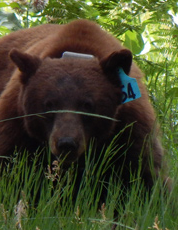
If you can, in all the excitement, try to notice if the bear has a tag (usually on the ear), the color of the tag and if possible, the number on it (the tag is large enough that with a telephoto lens you should be able to read the number).
The NPS notes: “Tagged, or radio collared, bears do not mean the bear is a “bad” bear. Tagging bears is done for better monitoring, and the ear tag color is completely random, used to help quickly identify a bear.”
From the Yosemite Daily Report newspaper:
“It is extremely important to remember to yell at bears that are in and around development, even if they are foraging on natural food. Though it is very tempting to get close for a picture, or just to watch these incredible animals, it is important not to give into this urge. Yelling at them if they are in residential areas or near people is critical to keep bears natural fear of humans. Giving bears plenty of space. When bears become too comfortable around people, they will often start causing damage to structures and vehicles, or will even become too bold around people, creating safety concerns.”
And the Yosemite Daily Report also said:
“Scare bears when you see them. . . in developed areas- Yell like you mean it!
Make as much noise as possible, try waving your arms, stomping your feet
or anything to make you look intimidating and to get the bear to run away.
We know it’s fun to see bears and it can feel mean to scare them,
but this is a simple way to truly help save a bear’s life.”



The author of this webpage, (written as a homework reading assignment for my students), does not give any warranty, expressed or implied, nor assume any legal liability or responsibility for the accuracy, completeness, or usefulness of any information, product, or process included in this website or at websites linked to or from it. Users of information from this website assume all liability arising from such use.

